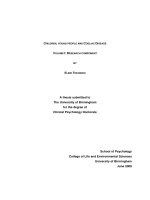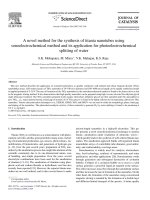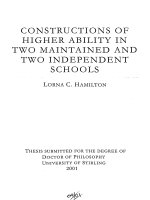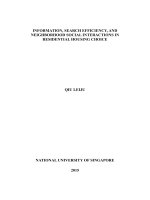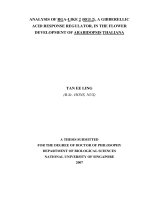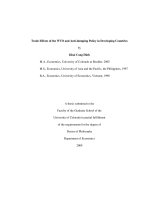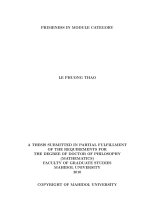A THESIS SUBMITTED FOR THE DOCTOR OF PHILOSOPHY
Bạn đang xem bản rút gọn của tài liệu. Xem và tải ngay bản đầy đủ của tài liệu tại đây (2.34 MB, 190 trang )
INFORMATION, SEARCH EFFICIENCY, AND
NEIGHBORHOOD SOCIAL INTERACTIONS IN
RESIDENTIAL HOUSING CHOICE
QIU LEIJU
NATIONAL UNIVERSITY OF SINGAPORE
2015
INFORMATION, SEARCH EFFICIENCY, AND
NEIGHBORHOOD SOCIAL INTERACTIONS IN
RESIDENTIAL HOUSING CHOICE
QIU LEIJU
(B. SCI., NJU; M. Eng., NUS)
A THESIS SUBMITTED
FOR THE DOCTOR OF PHILOSOPHY
DEPARTMENT OF REAL ESTATE
NATIONAL UNIVERSITY OF SINGAPORE
2015
DECLARATION
I hereby declare that this thesis is my current work and it has been written by
me in its entirety. I have duly acknowledged all the sources of information
which have been used in the thesis.
This thesis has also not been submitted for any degree in any university
previously.
__________________
Qiu Leiju
9 Feb, 2015
i
Acknowledgements
With joy together with challenge, it comes to the end of my Ph.D. study. This
thesis is the witness of an important step as a Ph.D. student, and it will also
become a milestone in my future journey of academic research. This thesis
would not have been completed without the support, encouragement, and help
of the people around me.
First of all, I would like to express my sincere thanks to my supervisor A/P Tu
Yong for her endless guidance and encouragement towards the completion of
this thesis. I am really grateful for her efforts in imparting knowledge and
experience on researching in real estate economics, and also for her
inspirational advice to my topic on housing choice behavior.
My deep appreciation also goes to my thesis committee members A/P Fu
Yuming and Dr. Lee Kwan Ok for their critical comments and invaluable
support throughout my research. I would like to thank A/P Yu Shi Ming and
Professor Ong Seow Eng for the discussion when I choose my research topic,
Professor Deng Yongheng and Dr. Lee Nai Jia for their comments when I
propose my research topic, and Dr. Li Pei for his comments and suggestions
throughout the research. I also would like to thank A/P Liao Wen-Chi for his
useful comments on this work, especially for the help on the coding of the
third part of this work. I wish to give my truly thanks to all the faculties in the
department of real estate who have taught me in or out of the classroom,
because they widely open my view and promote my understanding.
ii
I am indebted to all my seniors and postgraduate peers in the department of
real estate and all my colleagues in the department of physics. All of them are
extremely helpful with their assistance and friendship. They are including but
not limited to the following: Li Mu, Wei Yuan, Dr. Liang Lanfeng, Dr. Xu
Yiqin, Dr. Liu Bo, Dr. Wang Yourong, Dr. Guo Yan, Dr. Li Qing, Zhou
Xiaoxia, Zhang Liang, Dr. He Jia, Xuan Xu, Tang Yuhui, Luo Chenxi, Lai
Xiongchuan, Dr. Deng Xiaoying, Wang Yonglin, Zhang Bochao, Dr. Zhong
Yun, Dr. Yang Junjin, Jiang Mingxiu, Dr. Nidhi Sharma, Tao Ye, Lim Yen
Kheng, and etc. I would also like to thank the administrative staff members for
their effort to help during my study period, especially Zainab Binte Abdul
Ghani, Nor’Aini Binte Ali, and Zheng Huiming.
The financial support provided by National University of Singapore is
gratefully acknowledged.
Last but not least, heartfelt thanks will be given to my family for their kind
understanding and unconditional care, support and love. Thanks, my parents,
my sister, my brother-in-law, and my beloved niece. Thanks, my husband,
Daxuan. And thanks, my lovely sons, Lecheng and Peicheng.
iii
Table of Contents
Acknowledgements i
Table of Contents iii
Summary vi
List of Tables viii
List of Figures x
Chapter 1 Introduction 1
1.1 Research Background and Research Questions 1
1.2 Significance 15
1.3 Organization of the Dissertation 17
Chapter 2 Literature Review 19
2.1 Introduction 19
2.2 Housing Search and Information 21
2.3 Heterogeneous Characteristics of Households in Housing Choice 23
2.4 Stochastic Frontier Approach 25
2.5 Residential Location Choice 27
2.6 Social Interactions and Neighborhood Effect 30
2.7 Summary 34
Chapter 3 Background of Tianjin Housing Market and Data 36
3.1 Background of Tianjin Housing Market 36
3.2 Data 41
Chapter 4 Information and Housing Choice 44
4.1 Introduction 44
4.2 A Housing Search Model 46
iv
4.3 Data 57
4.4 Empirical Results 63
4.5 Robustness Test 70
4.6 Further Discussion 73
4.7 Conclusion 75
Chapter 5 Search Efficiency and Housing Choice 78
5.1 Introduction 78
5.2 Econometric Implementation 83
5.3 Data 87
5.4 Empirical Results 92
5.5 Robustness Test 104
5.6 Conclusion 112
Chapter 6 Neighborhood Social Interactions and Housing Location Choice
116
6.1 Introduction 116
6.2 A Residential Sorting Model with Neighborhood Social Interactions
120
6.2.1 Model 120
6.2.2 Econometric Implementation 123
6.3 Data 126
6.4 Empirical Results 141
6.5 Conclusion 150
Chapter 7 Conclusion 154
7.1 Review of the Research 154
7.2 Contributions 157
v
7.3 Limitations and Future Work 161
Bibliography 165
Appendix I List of Notations 172
Appendix II Hedonic Regressions for Subsamples 174
vi
Summary
This thesis analyzes the residential housing choice behavior from three
different angles, based on the features of housing market. First, information is
imperfect in housing market. Households have imperfect housing market
information; and different housing buyers may have different market
information levels. Housing search is a process in which households gather
information about the attributes of each choice alternative. The difference in
households’ information level plays a role in their housing choice. To study
this role, I examine the varied behaviors between informed and uninformed
households in housing market theoretically and empirically. In a housing
search model, it is found that the informed households are more likely to
secure a good deal in housing market. With the data from Tianjin city in
China, hedonic estimation is implemented to quantify the impacts of
information difference on housing search output. The results are consistent
with the theoretical predictions.
Second, households are heterogeneous in housing market. With heterogeneous
characteristics, households have different levels of information, different
ability to collect and assimilate information, different search costs, and
different bargaining power, so they would be likely to perform differently in a
housing search and to deliver different search outcome. This study defines
search efficiency as the probability of a household to secure a good deal to
measure its caliber in housing search. I address the factors determining the
performance of a household in its housing search. I adopt a modified
stochastic frontier approach to study the impact of households’ characteristics
vii
on their search efficiency using the data from Tianjin commercial housing
market in China. The results show that the probability of securing a good deal
is higher for a better informed household and households with lower income,
less education, lower ranks in occupation.
Third, households are always surrounded by neighbors, because their homes
are in a neighborhood. Their economic choice can be affected by their
neighbors, which researchers address as neighborhood effect. I study the
housing location choice behavior with the consideration of neighborhood
social interactions. I propose a collective choice model with different tastes of
households to show that households’ destination neighborhood choice is
impacted by their current neighbors. With the data from Tianjin China, the
estimation results show that social interactions among the current neighbors
significantly impact their destination neighborhood choice. The results also
show that old, high educated and rich households relatively value social
interactions more when they choose their destination neighborhoods.
Overall, this dissertation enriches the literature on housing choice behavior by
quantifying the impacts of information level, households’ characteristics, and
neighborhood social interactions. It also provides some policy implications to
the housing market in China. Housing market institution should be built to
reduce the market friction and increase households’ welfare. During the urban
redevelopment, more human factors should be considered by city planners,
because it is not only constructing housing units, but also building
communities, in which neighbors interact and further affect their economic
choice behaviors.
viii
List of Tables
Table 3-1 Observations of Housing Transactions in Each District of Tianjin. 42
Table 4-1 List of Variables. 58
Table 4-2 Descriptive Statistics of Variables. 59
Table 4-3 Descriptive Statistics of the Unit Housing Price for Different Groups
of Household. 61
Table 4-4 Hedonic Model with Market Information Premium with Full
Sample 66
Table 4-5 Information Premiums with Full Sample and Subsamples of High
Education Group and Low Education Group. 68
Table 4-6 Information Premiums with Full Sample and Subsamples of Resale
Group and New Sale Group. 71
Table 4-7 Hedonic Model with Distance to Workplace as Measure of Market
Information. 72
Table 4-8 Hedonic Model with the Competition among Home buyers. 74
Table 5-1 List of Variables. 89
Table 5-2 Descriptive Statistics of Variables. 90
Table 5-3 Stochastic Frontier Model of Housing Choice. 93
Table 5-4 Probability for Heterogeneous Households to Secure a Good Deal.
97
Table 5-5 Stochastic Frontier Model of Housing Choice with Characteristics of
Households. 98
Table 5-6 Probability for Heterogeneous Households to Secure a Good Deal
with Housing Price Equal to or Lower Than 90% of the Maximum Frontier
Price. 101
ix
Table 5-7 Probability for Heterogeneous Households to Secure a Good Deal
with Housing Price Equal to or Lower Than 95% of the Maximum Frontier
Price. 101
Table 5-8 Probability for Heterogeneous Households to Secure a Good Deal
with Housing Price Equal to or Lower Than 99% of the Maximum Frontier
Price. 102
Table 5-9 Stochastic Frontier Model of Housing Choice with Characteristics of
Households for Resale Subsample. 106
Table 5-10 Stochastic Frontier Model of Housing Choice with Characteristics
of Households for New Sale Subsample. 108
Table 5-11 Stochastic Frontier Model with Exponential Distributed Efficient
Component. 110
Table 5-12 Stochastic Frontier Model with Exponential Distributed Efficient
Component and Households’ Characteristics. 111
Table 6-1 List of Variables. 132
Table 6-2 Descriptive Statistics of Destination Neighborhoods. 132
Table 6-3 Descriptive Statistics of Households Mobility. 135
Table 6-4 Descriptive Statistics of Households’ Characteristics. 139
Table 6-5 Percentages of Households in Each Group. 140
Table 6-6 Regression Results of the Iterated c-logit Model with Eight Groups
of Households. 142
Table 6-7 Regression Results of the Single c-logit Model. 143
Table 6-8 Regression Results of the Iterated c-logit Model with Different Age,
Income, and Education Household Groups. 149
x
List of Figures
Figure 3-1 Population Distribution of Tianjin in 2007. 37
Figure 4-1 The Kernel Density of the Moving Distance. 69
Figure 6-1 Map of a Neighborhood. 128
Figure 6-2 Satellite Map of a Neighborhood. 129
Figure 6-3 Map of a Neighborhood. 129
Figure 6-4 Satellite Map of a Neighborhood. 130
1
Chapter 1 Introduction
1.1 Research Background and Research Questions
The dominant framework for micro economics to analyze markets is the
standard neo-classical framework. In this framework, the goods are assumed
to be homogeneous, which are also available to all the consumers without any
friction, like the transaction cost and search cost. Consumers and producers in
the market are assumed to be fully informed. The consumers are also taken as
homogeneous, who have no difference in their taste and preference.
Housing market is different from this neo-classical goods market in a few
aspects. Firstly, housing units as the goods in this market are heterogeneous.
Technically, it is not possible to find the two exactly same housing units in a
housing market. The heterogeneity of housing units arises from a number of
different factors. The heterogeneity exists explicitly because housing units are
differentiated by their types, sizes, ages, and etc. There is also dimensional
heterogeneity of housing units that they are located in different neighborhood
environments and may be more or less accessible to the infrastructures around,
employment centers or central business districts (CBD).
Adopting Lancaster's (1966) approach, the housing unit should not be viewed
as a homogeneous good, but as a complex commodity with a collection of
attributes or characteristics including location attributes and neighborhood
attributes as well as housing structure attributes, including housing type,
housing size, housing age, and etc.
2
Secondly, consumers in the housing market are also as varied as the housing
stock. They are primarily differentiated by income, demographic composition,
and family life cycle. They are possibly aggregated into consumer groups, and
their choice can be affected by their peers. The buyers from different groups
exhibit different housing choice behaviors. The utility derived from a housing
unit highly depends on the traits of a household. Thus, the decision to choose a
housing unit is influenced by a household’s social and economic background.
Thirdly, as a durable good, a housing unit is expensive; and housing
consumption is the biggest composition of the consumption during the whole
lifetime of a household. The National Income and Product Account (NIPA)
statistics show that the housing consumptions of the US households were
about 1.5 trillion dollars, which is 15.8% of the households’ budgets in 2009.
So households have only done their housing transactions for a few times in
their lifetime. The transaction in housing market is costly, and the transaction
cost cannot be neglected. Besides stamp duty tax which is widely implemented
in housing market of each country, other costs are also very high, e.g. agency
fee.
Fourthly, the properties of housing heterogeneity, locational fixity, durability
and costly transaction imply that trade friction exists inherently in the housing
market. Previous research on local housing market analysis emphasizes all
kinds of market frictions which can hinder the housing choice of households.
For example, Gyourko (1991) points out fiscal zoning restricts the types of
home available in suburban communities in the US; Rosenthal et al. (1991)
3
show that credit rationing prevents liquidity-constrained households from
attaining their long-term optimal housing choices in the US; Zheng, Fu and
Liu (2006) find that the poor marketability of the previously state-provided
homes, inadequate provision of housing finance, and spatial mismatch
between job-market and housing-market prevent the spatial equilibrium from
fully reflecting the location preferences of the urban residents in China.
Lastly, imperfect information, as one of the important market imperfection, is
especially worth to study, because it plagues the housing market. Households
have imperfect housing market information when entering the market; and
different home buyers may have different market information levels. It forces
a buyer to undertake extensive housing search and spend high search cost
before choosing a housing unit.
The above mentioned housing market properties of heterogeneous housing
units, heterogeneous households, imperfect information, high search cost and
search frictions make the housing choice a complicated process. Quigley
(1985) points out that the complex nature of a housing unit gives housing
choice three distinguishing features: the bundle of services provided by a
housing unit is extremely heterogeneous; a consumer faces a large bundle of
housing unit alternatives and selects one and only one housing unit from the
bundle each time; the choice involves the selection of a price as well as the
other characteristics associated with the housing unit.
On one hand, a home buyer makes his choice to maximize the utility. The
4
housing unit which he buys can bring him more utility as compared to any
other unit. Therefore, a home buyer has to undertake an extensive housing
search over different types of housing units as well as over locations in order
to find the optimal housing unit he wants. Previous literature on housing
choice considers households making decisions by weighting up each attribute,
like accessibility to workplace, shopping, and schools etc., housing price,
taxes, neighborhood amenities, availability of public services, dwelling
characteristics, and so forth, and then picking the optimal housing unit (e.g.
McFadden, 1978; and Quigley, 1985).
On the other hand, imperfect information is pervasive in a residential housing
market. The advertisement for the sale of housing units does not necessarily
convey information essential for buyers. For example, the detailed information
about the locational environment, especially some soft information, such as
the characteristics of neighbors, and etc., is usually not reflected. Housing
agency might not be sophisticated enough to provide all the detailed
information of the housing unit and the neighborhood. To gather information
of a housing unit, a personal visit is normally required for a home buyer.
However, because of high search cost in terms of considerable time, money
and effort, only a small sub-set of alternatives is selected and visited. To avoid
the uncertainty and high search cost, when a home buyer finds a unit with a
value higher than his expectation, he will accept it and stop the tiring and
costly process of visiting all the alternative housing units. This process of
residential housing choice is exactly a “search” process described in search
theory. The kernel of this search process is that search costs and uncertainty
5
stop a home buyer comparing all the alternative choices before making
decision. The housing unit that a household chooses might not be the optimal
one. Previous studies on housing search have shown this process (e.g.
Turnbull and Sirmans, 1993; Wheaton, 1990).
Considering the features of housing market and the complicated housing
choice decision making process, a lot of social factors have attracted interest
in the study of housing choice behavior. Firstly, since information is imperfect
in housing market, the information level of a home buyer is extremely
important to influence his housing choice. The studies, which consider the
information and output of housing search, starts from Turnbull and Sirmans
(1993). In their search model, the price-taking home buyers search from seller
to seller until the expected net gain from the entire search-purchase activity is
maximized. The main prediction of the housing search model is that the
informed home buyers have high probability to secure a good deal, i.e. paying
less on average for an identical housing unit, because they know the housing
market more accurately in the searching process. However, in the empirical
test of this prediction, by using first-time (or out-of-town) and repeat (or in-
town) buyers to proxy the information level, Turnbull and Sirmans (1993) find
positive but not significant results because of small sample. Watkins (1998)
replicates their study using 544 sales transactions from Glasgow in the United
Kingdom, and finds that there is no difference in price between intra-market
movers and immigrants. However, Lambson, McQueen, and Slade (2004) use
a large sample from Phoenix metropolitan area and find that non-Arizona
residents pay a premium of about 5.5% in comparison with the within-Arizona
6
counterpart. Ihlanfeldt and Mayock (2012) identify the distance between the
next housing unit and the previous address of households in a large number of
single-family home transactions from Florida, and show that the distant buyers
pay more for nearly identical housing units. So there is disagreement over
whether the less informed buyers pay a price premium for information.
Because information level of households cannot be measured directly, all the
measures in research are proxies. Due to this limitation, it is necessary to have
a more convincing test with more measures of information.
Secondly, households are heterogeneous. In a housing search process,
heterogeneous home buyers may obtain different outcomes of their search.
The previous literature points out home buyers’ heterogeneous characteristics
can influence their housing search performance through the channels of
information level, search cost, and bargaining power. Literature on housing
search (Ihlanfeldt and Mayock, 2012; Lambson, Macqueen and Slade, 2004;
Turnbull and Sirmans, 1993) shows that information level and search cost are
the key issues in housing search process, impacting on housing price.
Research on bargaining power finds that households’ characteristics influence
bargaining power and thus affect property transaction prices (Colwell and
Munneke, 2006; Harding, Knight and Sirmans, 2003; Harding, Rosenthal and
Sirmans, 2003; Ling, Naranjo, and Petrova, 2013).
Previous literature tries to quantify the impacts of home buyers’ heterogeneous
characteristics on their performance in a housing search. Empirically, the
duration and the number of search times are used to measure search efficiency
7
in Cronin (1982) and Anglin (1997). They find that various home buyers’
characteristics may influence the duration and search times. However, studies
using these measures of search efficiency are limited by data availability,
because it is typically difficult to find the housing search times undertaken by
a home buyer. In addition, the outcome of a housing search, i.e., whether it is a
good deal, is not considered in this stream of literature. If a home buyer spends
less time on a housing market or visits fewer housing units, he might not be
necessarily efficient, because he may not be able to secure a good deal.
The other stream of literature uses the price premium to measure home buyers’
performance in housing search, and study the impacts of home buyers’
characteristics on price premium. The information literature on housing search
compares the housing prices between informed and uninformed home buyers
(Ihlanfeldt and Mayock, 2012; Lambson, Macqueen and Slade, 2004; Turnbull
and Sirmans, 1993). The bargaining power literature compares the impacts of
different bargaining powers between buyers and sellers on property transaction
price (Colwell and Munneke, 2006; Harding, Knight and Sirmans, 2003;
Harding, Rosenthal and Sirmans, 2003; Ling, Naranjo, and Petrova, 2013). A
detailed review of these streams of literature can be found in Chapter 2.
Given the nature of housing search process, different performance of home
buyers in housing search is sourced from their different reservation values as
well as certain randomness (kind of luck to meet a housing unit with high
value). A housing unit, which randomly comes to the market, if it is better than
the reservation value, is accepted by the home buyer. Thus, higher reservation
8
value implies a higher probability to find a good deal in the housing market,
i.e., the home buyer performs efficiently in the housing search. The previous
literature has overlooked the stochastic nature of home buyers’ performance in
housing search. This requires a further study to quantify home buyers’
performance in housing search, and the impact of households’ heterogeneous
characteristics on it from another angle.
Thirdly, households are always surrounded by neighbors, because their homes
are in a neighborhood. Their choice behavior can be affected by their
neighbors, which researchers address as “neighborhood effect” (or
“neighborhood social interactions”) (Ioannides and Zabel, 2003).
Social scientists have been interested in analyzing the impact of social context
on the individual behaviors through the interactions which might also be
called “peer influence”, “social influence”, “social interactions”, “herd
behavior”, “neighborhood effect”, and the others (Manski, 2000). Generally,
social interactions are particular forms of externalities, in which the actions of
a reference group affect an individual’s preference (Glaeser and Scheinkman,
2000). Ioannides and Zabel (2003) define neighborhood effect as social
interactions originated in households’ residential place.
The influence of social interactions on the economic behaviour can arise from
several sources, including the endogenous interactions, the exogenous or
contextual interactions and the correlated interactions. The endogenous
interactions refer to the propensity of an individual to behave in some way
9
varies with the behaviour of the reference group; the contextual interactions
refer to the propensity of an individual to behave in some way varies with
exogenous characteristics of the group members; and the correlated
interactions refer to individuals in the same group tend to behave similarly
because they have similar but unobservable characteristics or face similar
unobservable institutional environments (Manski, 1993).
Residential location choice with social interactions has attracted interests in
research. The studies about the impact of social interactions on location choice
usually model the aggregate local demographic factor into RUM model. In this
type of model, social interactions are embedded in individual decisions and
location choice is a collective process (Bayer, McMillan and Rueben, 2009;
Brock and Durlauf, 2001, 2002, 2007; Follmer, 1974; Glaeser and
Scheinkman, 2000; Ioannides and Zabel, 2003). The details of this stream of
literature can be found in a comprehensive review in Section 2.6. The
empirical work with the consideration of the collective location choice
behavior has overall lagged behind the theoretical analyses, and they are from
different viewpoints. Bayer and his co-authors estimate a sorting model in
which the propensity of an individual to make location choice is a function of
the characteristics of others making the same choice (Bayer, McMillan and
Rueben, 2009; Bayer and Timmins, 2007). Ioannides and Zabel (2003, 2008)
estimate a model of the continuous housing services demand that is influenced
by the average of one’s neighbors’ housing demand. Kan (2007) estimates the
impact of social capital on residential mobility behavior, with a direct measure
of social capital from the survey data in the Panel Study of Income Dynamics
10
(PSID).
To my best knowledge, there is limited empirical research studying on the
impact of neighborhood effect on households’ next location choice, i.e., the
current neighbors’ behaviors affect the households’ next location choice
decision. In Bayer, McMillan and Rueben (2009), the propensity of an
individual to make a choice is affected by the characteristics of others making
the same choice, i.e. households who move into the same neighborhood.
Ioannides and Zabel (2008) estimate the demand for housing and
neighborhood choice as a joint decision. Their estimation on the housing
demand part is on the neighborhood effect, in which the current neighbors’
behavior affects the propensity of household’s housing demand. But their
study on the neighborhood choice part is the same as the one in Bayer,
McMillan and Rueben (2009), which focuses on the contextual interactions
among those who make the same neighborhood choice decision. Research,
which can fill in this literature gap by providing the empirical evidence on the
impact of neighborhood effect in the current neighborhood on the next
residential location choice, is required.
Overall, due to the housing market properties of imperfect information, high
search cost, search frictions, information level, heterogeneous housing units,
heterogeneous households, and neighborhood social interactions, the housing
choice behavior is a complicated process still without fully understand. To
solve the above mentioned three problems, it should attract more close
observations to study the housing choice behavior. Following the three strands
11
of literature which consider the social factors of information level and search
cost, heterogeneous households’ characteristics, and neighborhood effect (or
neighborhood social interactions), in the housing choice behavior, this
dissertation tries to further understand the housing choice behavior from these
three aspects. It constitutes three major objectives.
(1) to scrutinize a household’s housing choice behavior from its housing
search process with the consideration of location-dependent information,
where location-dependent information refers to different information levels in
different locations for the household;
(2) to quantify the impacts of a household’s characteristics on the performance
of its housing search;
(3) to estimate the influence of neighborhood social interactions on a
household’s housing location choice.
To achieve the three objectives, three main research questions are answered in
this dissertation, which are listed as follows.
(1) Does a household’s location-dependent information affect its housing
choice?
(2) How do the characteristics of a household impact on the housing search
performance?
12
(3) Do the current neighbors influence a household’s destination neighborhood
choice?
The first question is answered in Chapter 4. I analyze the role of information
in housing choice theoretically and empirically. Theoretically, a housing
search model is proposed, in which the households’ location-dependent
information level is captured in the shift of housing surplus value. It is found
that the informed households are more likely to secure a good deal. With the
data from Tianjin city in China, more measures of households’ information
level can be identified. Hedonic estimation is implemented to quantify the
impacts of information difference on the housing search output. Specifically,
the sub-questions I test are as follows: (1) Does a home buyer with
information disadvantage pay more for a housing unit than his counterpart? (2)
Does this information price premium depend on the distance between the next
housing unit and the current housing unit, since housing information decays
with this distance? The results show that the home buyers at information
disadvantage need to pay 1%-2.3% more than the better informed home
buyers, which are consistent with the theoretical prediction. The information
price premium does depend on the distance between the next housing unit and
the current housing unit. The answers to these questions allow having a further
understanding in the role of information in housing choice, which also meet
the first objective of this dissertation.
The second question is answered in Chapter 5. I study the households’
heterogeneous characteristics into housing choice behavior, and quantify the
